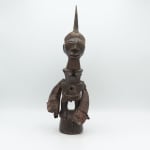Songye Nkisi Figure, 19th-20th century CE
Mixed media
height 37.9 cm
height 14 7/8 in
height 14 7/8 in
EL.0072
Further images
-
(View a larger image of thumbnail 1
)

-
(View a larger image of thumbnail 2
)

-
(View a larger image of thumbnail 3
)

-
(View a larger image of thumbnail 4
)

-
(View a larger image of thumbnail 5
)

-
(View a larger image of thumbnail 6
)

-
(View a larger image of thumbnail 7
)

-
(View a larger image of thumbnail 8
)

This wooden figure stands on a rounded pedestal, elevating its body and assigning it a sense of importance. It has large feet and short legs, and some kind of material...
This wooden figure stands on a rounded pedestal, elevating its body and assigning it a sense of importance. It has large feet and short legs, and some kind of material tied around its waist. Its shoulders are thrown back, with its elbows extending behind it, but its hands rest on its rounded abdomen. A piece of string is tied around the elbows at the back. There is a deep hole representing the belly button. On top of the flat shoulders, a long neck supports a large head. A quadrilateral beard extends from the chin, decorated with textured zigzag patterning. The mouth above the prominent chin is slightly open, below a triangular nose and large almond-shaped eyes which appear partially closed. The figure’s hair is textured at the front of its head with carved squares, and a horn has been set into the top of the head. Three horns are also suspended from metal rings around the arms.
This is a nkisi figure (pl. mankishi), created by the Songye people who originate from the Democratic Republic of the Congo. The Songye people are known for living in farming communities, but they also participate in hunting and trade. Ancestor worship plays an important role in Songye culture, and mankishi are a vital element of this. Mankishi are spirits of the dead which can be malevolent or benevolent, and are believed to have the power to affect the fate of a community. Nganga, who are magical practitioners, commission mankishi sculptures in order to serve a particular function, such as protecting the community or promoting fertility. Some are created for entire communities, but there are also personal domestic examples. The nganga will also create bishimba (medicines) from parts of powerful animals, such as bones, fur, or claws, and insert them into holes in mankishi, often in the abdomen or the head. These are believed to invoke the spirit world, and are associated with great power and strength. A large part of the significance of a nkisi comes from the bishimba inserted and the spiritual knowledge used in creating it, but the physical appearance of the figure is also highly important. Their pose often indicates their readiness to carry out their task, and the pedestal base contributes to the overall sense of strength. A long square beard is an attribute associated with good leadership. The rounded abdomen, a common feature, symbolises fertility and the cycle of life. It acts as a way of connecting the community’s ancestors to its unborn members.
This is a nkisi figure (pl. mankishi), created by the Songye people who originate from the Democratic Republic of the Congo. The Songye people are known for living in farming communities, but they also participate in hunting and trade. Ancestor worship plays an important role in Songye culture, and mankishi are a vital element of this. Mankishi are spirits of the dead which can be malevolent or benevolent, and are believed to have the power to affect the fate of a community. Nganga, who are magical practitioners, commission mankishi sculptures in order to serve a particular function, such as protecting the community or promoting fertility. Some are created for entire communities, but there are also personal domestic examples. The nganga will also create bishimba (medicines) from parts of powerful animals, such as bones, fur, or claws, and insert them into holes in mankishi, often in the abdomen or the head. These are believed to invoke the spirit world, and are associated with great power and strength. A large part of the significance of a nkisi comes from the bishimba inserted and the spiritual knowledge used in creating it, but the physical appearance of the figure is also highly important. Their pose often indicates their readiness to carry out their task, and the pedestal base contributes to the overall sense of strength. A long square beard is an attribute associated with good leadership. The rounded abdomen, a common feature, symbolises fertility and the cycle of life. It acts as a way of connecting the community’s ancestors to its unborn members.







